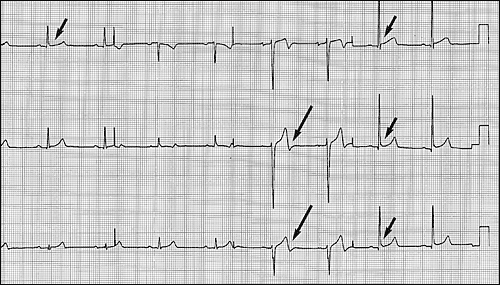
Am Fam Physician. 2000;62(6):1264
The article titled “The Preparticipation Athletic Evaluation” (May 1, 2000, page 2683) contained several errors. The legend to Figure 1 contained two errors; the ST elevations in leads I, V4, V5 and V6 should have been referred to as lateral leads, rather than anterior leads, and the T waves in V2 and V3 should have been referred to as biphasic, rather than inverted. In the first full paragraph on page 2687, the word “echocardiography” was erroneously abbreviated as ECG. Table 2 contained an incorrect reference to Figure 1. The table should have referred readers to the Appendix following the article, on page 2696. The corrected figure and table are reprinted below.

| Examination feature | Comments |
|---|---|
| Blood pressure | Must be assessed in the context of participant's age, height and sex (see Table 3). |
| General appearance | Measure for excessive height and observe for evidence of excessive long-bone growth (arachnodactyly, arm span > height, pectus excavatum) that suggest Marfan syndrome. |
| Eyes | Important to detect vision defects that leave one of the eyes with > 20/40 corrected vision. Lens subluxations, severe myopia, retinal detachments and strabismus are associated with Marfan syndrome. |
| Cardiovascular | Palpate the point of maximal impulse for increased intensity and displacement that suggest hypertrophy and failure, respectively. |
| Perform auscultation with the patient supine and again with the patient standing or straining during Valsalva's maneuver. | |
| Femoral pulse diminishment suggests aortic coarctation. | |
| Respiratory | Observe for accessory muscle use or prolonged expiration and auscultate for wheezing. Exercise-induced asthma will not produce manifestations on a resting examination and requires exercise testing for diagnosis. |
| Abdominal | Assess for hepatic or splenic enlargement. |
| Genitourinary | Hernias and varicoceles do not usually preclude sports participation, but the sports examination can also serve as an appropriate time to screen for testicular masses if the athlete is not receiving regular general examinations. |
| Musculoskeletal | The two-minute orthopedic examination (see Appendix, p. 2696) is a commonly used systematic screen. Consider supplemental shoulder, knee and ankle examinations. |
| Skin | Evidence of molluscum contagiosum, herpes simplex infection, impetigo, tinea corporis or scabies would temporarily prohibit participation in sports where direct skin-to-skin competitor contact occurs (e.g., wrestling, martial arts). |